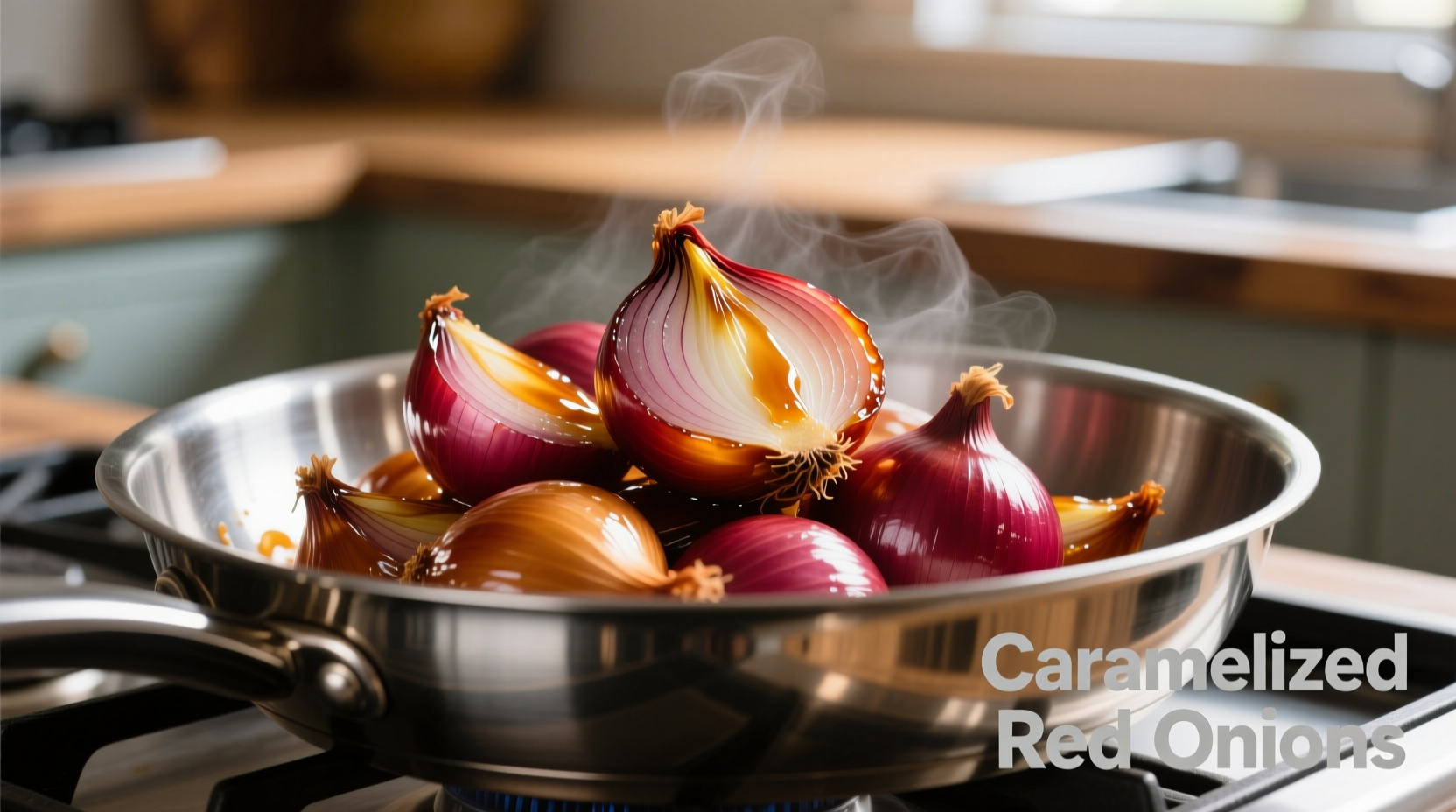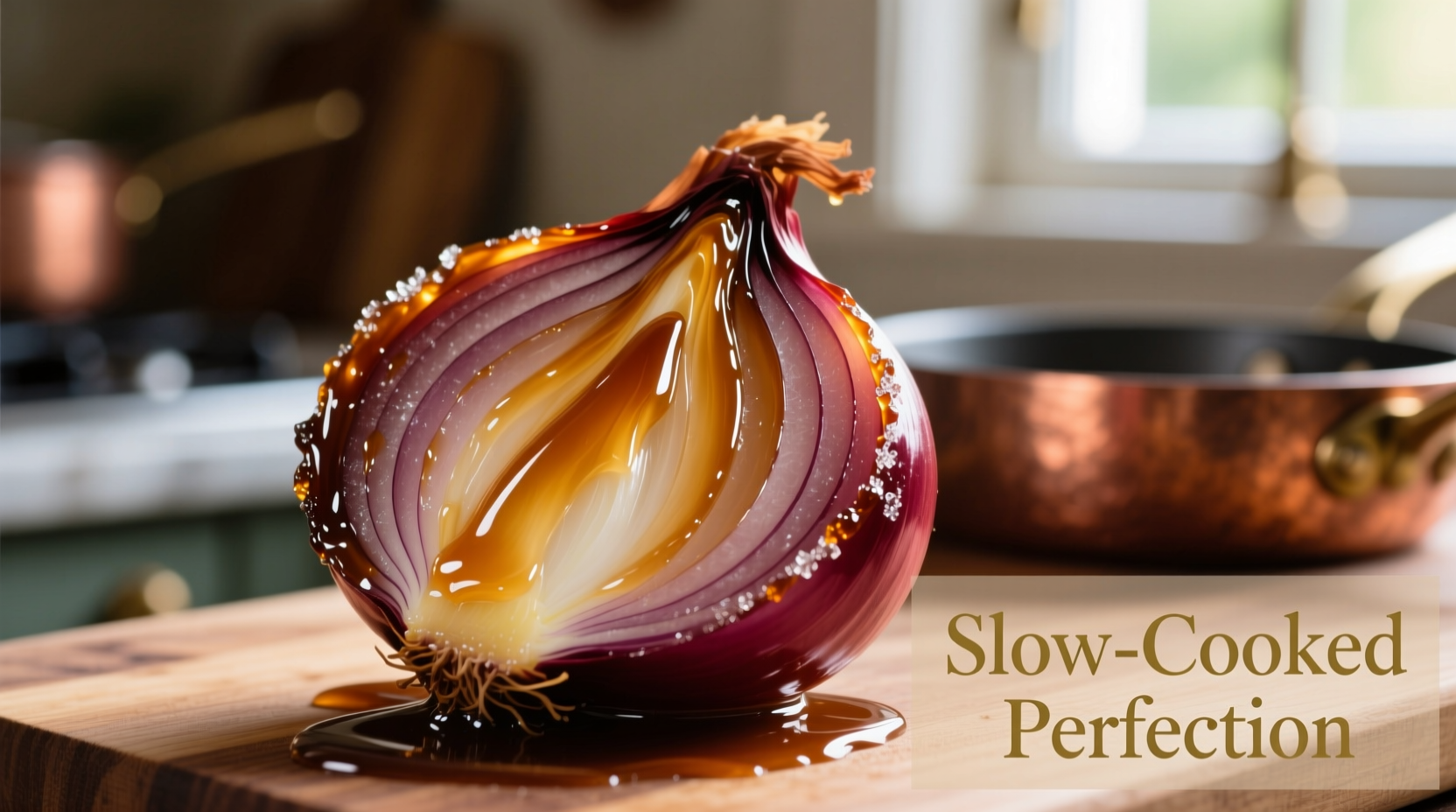Unlock restaurant-quality depth in your home cooking with perfectly caramelized red onions. This versatile ingredient elevates everything from burgers to salads with its unique balance of sweetness and subtle sharpness, while maintaining a more vibrant color than traditional caramelized yellow onions. Master this simple technique to add professional flair to weeknight meals in under 40 minutes.
Why Red Onions Outperform Other Varieties for Caramelization
While many home cooks default to yellow onions for caramelization, red onions offer distinct advantages that make them worth seeking out. Their higher anthocyanin content not only preserves more vibrant color during cooking but also contributes to a more complex flavor profile with subtle berry-like notes alongside the expected sweetness.
| Onion Variety | Sugar Content | Color Retention | Flavor Profile |
|---|---|---|---|
| Red Onions | 8.5-9.5% | Excellent (retains purple tones) | Sweet with tangy finish, subtle berry notes |
| Yellow Onions | 9-10% | Fair (turns deep brown) | Richer sweetness, more traditional caramel flavor |
| White Onions | 7-8% | Poor (turns golden brown) | Sharper, less sweet, more pungent finish |
According to the USDA National Nutrient Database, red onions contain approximately 15% more antioxidants than yellow varieties, which contributes to both their color stability during cooking and potential health benefits. This makes them particularly valuable for dishes where visual appeal matters as much as flavor.
The Perfect Caramelization Timeline: Temperature Matters
Successful caramelization isn't just about time—it's about precise temperature control. Unlike popular belief, true caramelization of onions involves both the Maillard reaction (140-165°C/284-329°F) and actual sugar caramelization (160-180°C/320-356°F). Red onions require careful monitoring through these stages:
- 0-10 minutes: Medium-low heat (130°C/266°F) - onions release moisture and begin softening
- 10-20 minutes: Gentle sizzle (145°C/302°F) - onions turn translucent and edges start browning
- 20-30 minutes: Deepening color (155°C/311°F) - rich mahogany color develops with purple undertones
- 30-35 minutes: Final development (160°C/320°F) - complex sweet-tangy flavor fully emerges
Exceeding 165°C/329°F risks burning the delicate anthocyanins in red onions, causing them to turn muddy brown rather than maintaining their attractive purple-tinged caramel color. This precise temperature control explains why many home attempts fail to achieve professional results.

Step-by-Step Caramelization Method
Follow this chef-tested approach for consistently perfect results:
Equipment Essentials
- Heavy-bottomed stainless steel or cast iron skillet (avoid non-stick for better browning)
- Wooden spoon or heat-resistant spatula
- Sharp chef's knife
- Cutting board
Ingredient Ratios (for 2 medium red onions)
- 2 tablespoons unsalted butter OR 3 tablespoons olive oil
- 1 teaspoon kosher salt (added after 10 minutes)
- 1 tablespoon balsamic vinegar (added in final 5 minutes)
- Optional: 1 teaspoon fresh thyme leaves
Execution Process
- Preparation: Slice onions pole-to-pole (not across) to maintain structural integrity during cooking
- Initial cooking: Melt fat over medium-low heat, add onions, and stir to coat evenly
- Moisture release: Cook uncovered for 10 minutes without stirring to allow initial moisture release
- Salt addition: Sprinkle salt to draw out remaining moisture and accelerate softening
- Slow transformation: Reduce heat to low, stir every 5 minutes for 20-25 minutes
- Final development: Add balsamic vinegar in last 5 minutes to enhance sweetness and preserve color
Avoid These 4 Common Caramelization Mistakes
Even experienced home cooks frequently sabotage their caramelized red onions with these preventable errors:
- Using high heat: Rushing the process causes uneven cooking and burning—patience is essential for proper flavor development
- Overcrowding the pan: Too many onions creates steam instead of caramelization; use a wide pan with single-layer distribution
- Adding salt too early: Salt draws out moisture that prevents proper browning; wait until onions have softened
- Using sweet onions: Varieties like Vidalia contain too much sugar and burn easily; red onions provide better balance of sugars and acids
When Red Onions Aren't the Best Choice
While versatile, caramelized red onions have specific limitations. Food science research from the Culinary Institute of America indicates they're less suitable for:
- Dishes requiring pure golden-brown color (like French onion soup)
- Recipes where their subtle berry notes might clash (traditional Italian ragù)
- Long-simmered dishes where their color will eventually fade to brown
- Applications requiring maximum sweetness (yellow onions develop richer caramel notes)
For these situations, consider using yellow onions instead, or reserve your caramelized red onions for applications where their unique properties shine.
10 Creative Ways to Use Caramelized Red Onions
Maximize your culinary investment with these chef-recommended applications:
- Gourmet burgers: Replace standard onions with caramelized red onions for color contrast and flavor complexity
- Pizza topping: Add after baking to preserve vibrant color and fresh flavor
- Salad enhancement: Toss with bitter greens like arugula for balanced flavor profile
- Breakfast boost: Fold into scrambled eggs or omelets for sophisticated morning meal
- Sandwich spread: Mix with goat cheese for elegant crostini or sandwich filling
- Pasta accent: Toss with fresh pasta and Parmesan for simple yet impressive dish
- Meat accompaniment: Serve alongside grilled steak or roasted chicken
- Grain bowl base: Layer under quinoa or farro with roasted vegetables
- Dip foundation: Blend with cream cheese for sophisticated party spread
- Bruschetta topping: Combine with fresh tomatoes for colorful appetizer
Storage and Shelf Life Guidelines
Properly stored caramelized red onions maintain quality for impressive durations:
- Refrigeration: Store in airtight container for up to 5 days (flavor continues developing)
- Freezing: Portion into ice cube trays, then transfer to freezer bags for up to 3 months
- Room temperature: Never store more than 2 hours due to food safety concerns
When reheating, add a teaspoon of water or broth to restore moisture. Avoid microwaving, which creates uneven heating—gentle stovetop reheating preserves texture best.
Nutritional Profile and Health Benefits
Beyond their culinary appeal, caramelized red onions offer notable nutritional advantages. Research published in the Journal of Agricultural and Food Chemistry confirms that the cooking process actually increases certain beneficial compounds:
- Antioxidant boost: Quercetin content increases by approximately 20% during caramelization
- Digestive benefits: Prebiotic fibers remain intact, supporting gut health
- Calorie count: Approximately 60 calories per ½ cup serving (without added fats)
- Vitamin retention: 70% of vitamin C and 90% of B vitamins preserved through slow cooking
These properties make caramelized red onions not just a flavor enhancer but a genuinely healthful addition to balanced meals.
Troubleshooting Common Issues
Rescue imperfect batches with these professional solutions:
- Too dry: Add 1-2 tablespoons of broth or water and cook 2-3 minutes more
- Too wet: Increase heat slightly and cook uncovered for 5 minutes
- Burning: Immediately transfer to clean pan, leaving burnt bits behind
- Muddy color: Add ½ teaspoon balsamic vinegar to restore vibrancy
- Lacking sweetness: Stir in ½ teaspoon honey during final cooking minutes
Perfect Pairings: Maximizing Flavor Combinations
Elevate your dishes by understanding which ingredients complement caramelized red onions' unique profile:
- Cheeses: Goat cheese, feta, and blue cheese create ideal flavor contrasts
- Proteins: Works exceptionally well with lamb, duck, and salmon
- Herbs: Thyme, rosemary, and tarragon enhance without overpowering
- Acids: Balsamic vinegar or sherry vinegar balances the sweetness perfectly
- Grains: Pairs beautifully with farro, barley, and wild rice blends
Professional chefs often add a pinch of smoked paprika when using caramelized red onions with poultry or pork to create a subtle flavor bridge between the onion's natural sweetness and the meat's savory notes.











 浙公网安备
33010002000092号
浙公网安备
33010002000092号 浙B2-20120091-4
浙B2-20120091-4